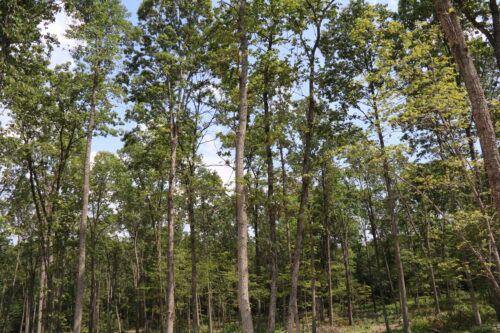Forest Management and Why It Is Important
 Forests are the natural land cover of Virginia, and are influenced by soils, rainfall, storm events, insects, diseases, and wildfire and controlled fire. Forests are essential to our wellbeing. They provide wood for a multitude of products, food, shelter, and cover (habitat) for birds, animals and insects. Forests intercept rainfall, slow it down as it soaks into the layers of leaves on the ground, and prevents soil from washing into creeks, streams, and rivers, keeping water clean. Forests also take in carbon dioxide and release oxygen, in effect cleaning the air, and provide cooling shade on hot days. Finally, forests are beautiful, providing attractive landscapes and settings for outdoor recreation.
Forests are the natural land cover of Virginia, and are influenced by soils, rainfall, storm events, insects, diseases, and wildfire and controlled fire. Forests are essential to our wellbeing. They provide wood for a multitude of products, food, shelter, and cover (habitat) for birds, animals and insects. Forests intercept rainfall, slow it down as it soaks into the layers of leaves on the ground, and prevents soil from washing into creeks, streams, and rivers, keeping water clean. Forests also take in carbon dioxide and release oxygen, in effect cleaning the air, and provide cooling shade on hot days. Finally, forests are beautiful, providing attractive landscapes and settings for outdoor recreation.
Good management can be described as a wise use of one’s resources and abilities to accomplish a successful outcome. Forest management – applying practices or treatments to the forest – helps to achieve specific forest benefits for the landowner and in turn can help meet the needs of everyone living in Virginia. Forest management practices are based upon the science of how different types of trees and forests grow. Skillfully applying these practices helps the landowner meet their forest management goals and objectives in ways that are effective and efficient. Professional foresters are trained to help landowners by developing plans and applying forest management practices that will achieve the desired objectives and benefits.
An example of this process is “thinning.” Most trees produce an abundance of seeds, so new forests often have lots of young trees growing close together. Naturally, over time, the strongest trees outgrow the weaker ones that eventually die, but it can take a very long time for this to happen. A forest management practice called “thinning” is where the best trees are selected to stay, and the others are removed. By doing this, the best trees have lots of room (sun and moisture) to grow better, faster, and larger than they would without this treatment. The result of management is a healthier forest and one that is likely more valuable.
